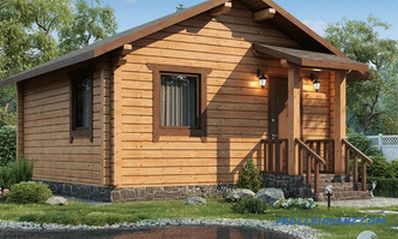Milling provides virtually unlimited possibilities for processing workpieces. The formation of edges, grooves and grooves of different depths and shapes - for each operation there are different types of cutters for wood for a manual router, allowing you to perform the work as efficiently as possible. What are the cutters in size, shape, design and types of blades - all the necessary information in one review.
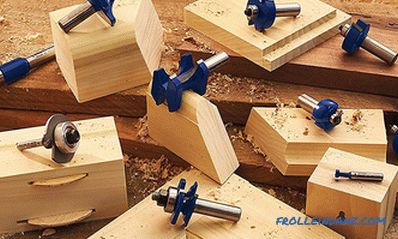
Types of diameter of the shank
Before you choose a cutter, you must first determine the method of its fastening, or more precisely, in what units the diameter of the shank is measured - inches or millimeters. It depends on what sets of collet - sleeves, in which the shank is clamped, come complete:
- If they are measured in millimeters, then the most common ones are 6, 8 and 12 mm.
- When the size is specified in inches, it is usually necessary to choose from only two of them - it is a quarter and a half of an inch.
This is important! When converting inches to SI units, 6.35 and 12.7 mm are obtained, but, despite such a slight difference, the millimeter shank is incompatible with the inch collet and vice versa. The shaft of the milling machine rotates at a speed of up to 25,000 revolutions per minute, so the slightest discrepancies will entail, at best, damage to the tool.
Types of construction of mills
Depending on the cost and purpose, they are produced in the following structural modifications:
Prefabricated
At the heart of such a steel pig required shape, to which the cutting edges are welded. Due to the ease of manufacture, most of these models are on the market.

With interchangeable cutting edges
They have a long service life, since the knives for them are double-sided - when the blade is blunt, it is turned over.

Monolithic
The cutting edges are turned right at the base - when working with such tools, even the hypothetical possibility disappears that the blade will break off, but after a few sharpening the cutter will have to be changed .
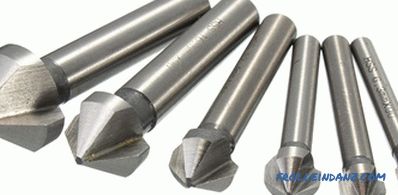
Types of cutter blades
Cutters come in a vertical, inclined or spiral arrangement of the blades. If they are straight, then pieces of wood will be cut from the workpiece, and inclined ones will be cut, which reduces the likelihood of chipping and increases the overall quality of milling.
According to the material and characteristics of the blade are available in two types:
- HM - high-speed. Used for processing soft wood or aluminum.
- HSS - carbide. Designed for hard materials, so these cutting edges have a better temperature coefficient and other characteristics, which also affects their price.
In addition to the blades, depending on the place and shape you need to get the cut in the workpiece, the appropriate types of cutters are used for the manual wood milling machine.
Slot mills
Designed to select a groove of the required width and depth in the middle of the part or from its edge and toward the center. Most often used to create a thorn-groove joint. If necessary, if the design of the stop of the milling machine allows, the width of the groove can be adjusted without changing the cutter to a larger diameter.
Slot straight lines
The simplest tool has a cylindrical shape, after which a rectangular cross-section groove remains in the workpiece. It is mainly used with submersible milling machines, although it is possible to use them with other models.

Groove fillet
Their cutting head has a rounded shape, so that the groove in the section resembles the letter "U" - depending on the depth of cut, the walls are rounded immediately from the surface of the workpiece or at first some time go from it at a right angle.
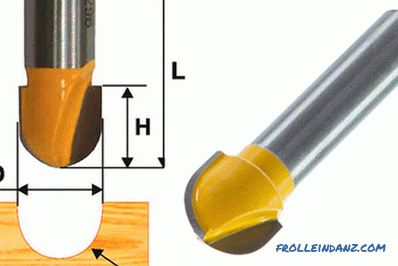
Slot fillet V figurative
Although by definition "fillet" is a semicircular notch, the cutter, which in the section "V" -shaped groove. If the work involves the manufacture of grooves with different angles of inclination of the walls, then you need to have the appropriate set of tools.
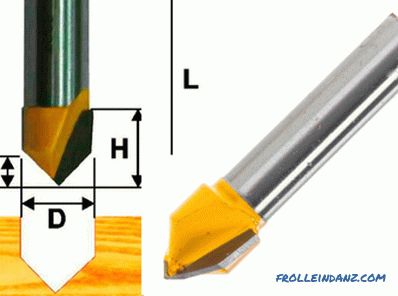
Slot constructional (T shaped and dovetail)
In the cross section, the resulting grooves form an inverted "T", the base of which goes to the surface or the correct trapezium, the large side of which faces the center of the workpiece. This is one of the most reliable connections, the workpieces slide into one another and it will not work out in another way.
Groove-shaped
Along with fillet, it is used to get shaped carving and edge processing. In cross section, the grooves resemble braces. You can mill as grooves in the center of the workpiece or remove the edges from its edges. If a complex drawing is made, then it is recommended to pass a straight groove cutter along its contour - this will simplify the subsequent alignment and reduce the load on the milling machine when using a shaped cutter.
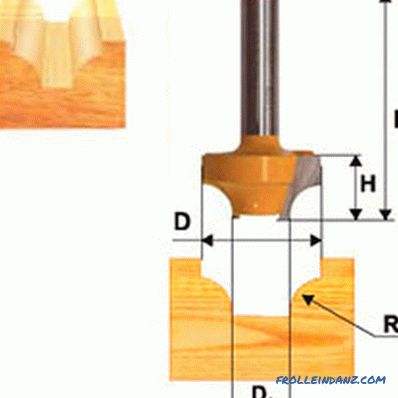

Edge milling
Most commonly manufactured with a bearing which allows you to process the edges and ends of the blanks, not only by setting the reference table, but also by the template.
Edging lines
To obtain the plane of the end face of the workpiece, perpendicular to the plate (top of the workpiece). If there is a bearing on the mill, it is possible to handle rounded edges. The bearing itself can be configured flush with the cutting blades or have a larger / smaller diameter, which expands the possibilities of using tooling.
Edging moldings
To get a straight, arcuate or wavy shaped edge - depending on the part of the cutter used, you can soften the edge of the workpiece, round it up (double cutters allow you to do it in one pass), make an edge with a fold and a sponge or get a semi-stud. Widely used for the manufacture of ornaments of complex shape. When choosing a double cutter, you need to pay attention to the possibility of adjusting the distance between the cutting blades.

Hemming edge adjustable cutter.
Edge-seam
Used when necessary to choose a groove of a rectangular shape or a quarter on a flat or curved workpiece. Using a double pass, get the spike of the desired size. The depth of sampling is regulated by the position of the milling machine or the thrust bearing.

Edge-taper
Depending on the angle of the cutter's edge, they are used to prepare blanks before joining, to obtain a decorative chamfer or to work on furniture parts, which then will be connected to the product round (polygonal) shape.
Edging fillet
Used to produce a rounded groove on the edge of a straight or shaped blank. To exclude the possibility of skewing the cutter, is made with two bearings. The result of the work is the same as when using mortise fillet mills, but in some cases it is much more convenient to use edge edgers.
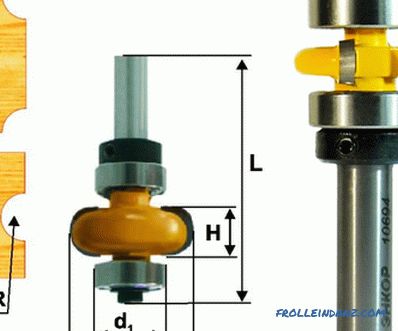
Trimmed
Another name is multi-profile. Since they are quite massive and at the same time work with a large area of workpiece, the use of such cutters is recommended on milling machines with a capacity of not less than 1600 watts. For work, the entire profile of the milling cutter is used at once or in various combinations, which allows to get the edge of a standard or specified by the master form.
Half-flanged edge
The direct purpose of the cutter is to work the edges of the workpieces to produce a semicircular protrusion. There are also many additional methods of application - for example, if you handle a rectangular billet on both sides with such a mill, it will become the core. In addition, with its help, profiles with a chamfer and an edge of a complex shape are obtained, as well as hinged joints (when processing the workpiece together with a fillet or a cutting mill).
Combined cutters
Used for joining and splicing wooden blanks - combining them along the edge (for corner joints) or the end part (for a wide board of several small ones). Combined milling cutters combine slot and spike mills, and are designed to create both of these elements in a single pass. The use of milling for this purpose increases the glued area of the boards and polishes the surfaces for their maximum fit to each other.
Combined universal
Allows you to get combinable planes with a spike and a groove angled to each other. The same milling cutter is used for both jointed blanks - since it does not have to be changed, this significantly reduces the processing time.
Groove-Spiked
A set of two separate cutters is used - to create a groove in one workpiece and a spike in the other. Additional measurements and fittings are not required, since the dimensions of the cutting edges are already calculated during the manufacture of the tool.
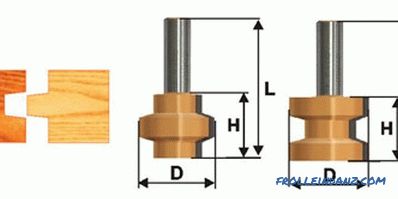

For the manufacture of lining
They are used on the same principle as tongue and groove , but they allow to get the connection of the figured form with a greater area of contact between the blanks, which improves the characteristics of the lining produced in this way.
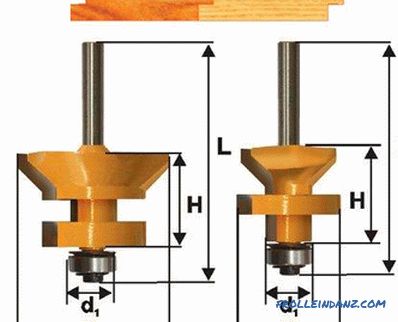
Combined frame
Type milling cutters that allow cutting blades to be placed on the axis in the order of the master. Consist of base, cutting blades, thrust bearings (one or more), lock washers and lock nuts. When you change the configuration of the cutter, its base is not removed from the collet of the milling machine, in order to preserve its initial setting.
Milling cutters
The main purpose is decorative processing of the edges of the parts used to create panels. Figurae cutters are equipped with a bearing, so you can work with rectangular and figured blanks.Since the panels are usually large parts, the average diameter of the cutters is 50-70 mm - for their use it is desirable to use a milling machine with a capacity of 1500 watts or more.
Horizontal figure
Used for partial processing of the panel. Since the shape of the cutter involves sampling, starting from the thrust bearing - this does not allow you to immediately get a spike to insert the panel in the frame. For its formation requires additional processing edge.
Horizontal double-sided figurines
Considerably simplify the work process, since part machining can be performed in a single pass of the cutter, forming at the same time the figured part of the panel and the spike for the groove cut in the frame.
V-shaped verticals
First of all, such cutters are used for making baseboards of various shapes, but in practice their capabilities are much wider - it all depends on how you set up and keep the milling machine. After processing, a decorative frame and spike joint is formed on the blank.
These are all the main types of cutters for wood for a manual router, but it must be additionally taken into account that each of them is made in several sizes, so a professional cabinetmaker must have a separate cabinet of rather large sizes for their storage.


Photos of the famous
manufacturer of cutters Enkor were used.




